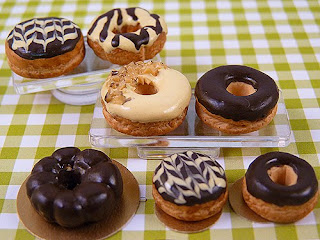Miniature piping bags can be hand-made using small plastic sachets and curling a stretch of "foil teeth" from a aluminium foil or plastic wrap box. Yoyo Studio's tutorial is one of the more well-known ones to teach clay cream piping.
The difference between hand-made nozzles for miniatures and icing tips is simply -- clay wastage. Icing tips are larger and you will have a bit of clay left over after finishing whatever you have in the bag. For the miniature foil nozzles, you reduce on clay wastage.
If you aren't that nit-picky on the clay and if you're fat-fingered like I am who can't curl a length of foil teeth for nuts, just stock up on Wilton icing tips with the smallest number for the series.
These were done with a Wilton Open Star Tip 13 and a normal plastic piping bag which I cut into half since I didn't need such a big bag. Make sure you tape the plastic bag to your icing tip as it can move and mess up your piping. You probably can get a vague idea of the tip-size with this link. I used pure Grace Soft White Cream Clay. If you are not sure how to handle a piping-bag, Google turns up a few good tutorials like 1M Swirl Cupcake Icing tutorial one on Wilton's own site.
You can also make a soft cream-like clay that can be piped easily by soaking pieces of air-dry clay in water along with talcum powder. Use enough water to soften the clay to a mushy texture but don't over-soak it else you will take a very long time to get it back to a drier state. Use acrylic colors to mix in if you want to get an opaque feel to your prepared cream.
Piped some cream into a few raw-looking tartlet bases. The metal tip makes it very easy to use. If you have been attempting with plastic icing tips, the tip will not be able to 'cut' and release the clay well. The larger piping bag is easy to hold and use for people with a not too steady grip. :)








































